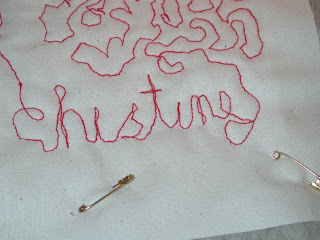
This Singer 101 is the same kind of machine I learned to sew on long ago. My parents were off to New York to attend a meeting and my grandmother stayed home with me in California. I must have been around eight years old. I had watched my mother sew for hours and hours. I knew all of her motions and the sounds the machine made. She made dresses for me, drapes, curtains, and even did some upholstery. She also did smocking and hand appliqué. My mother was very good and her work was beautiful. She did not own a seam ripper – she hardly ever made mistakes.
I opened the machine, flipped it up and switched on the light. The machine was already threaded. I told Nana that I was going to make doll clothes. There was plenty of material in my mother’s stash. Nana asked, “Do you know how to sew on the machine?” I assured her that I did. I sewed happily for hours until I ran out of bobbin thread. I didn’t have a clue about filling a bobbin so I had to stop. My grandmother did not know how to operate a sewing machine so she was no help.
My mother was very surprised to see my work when she returned from New York. She asked if Nana had taught me and I avoided a direct answer. I did ask my mother how to replace the bobbin.
I inherited my mother’s 101 and used it for several years, but I gave it away to a friend. I thought “a sewing machine is a sewing machine.” I bought a brand new Singer with lots of bells and whistles. It was a complete disaster. It turned me away from sewing for a long time. In 1993 I took up quilting. My machine was so hard to use. I could not make a decent quarter-inch seam. It was discouraging. One day I found a little Featherweight in a junk store and learned again what a pleasure sewing was.
We bought many old sewing machines, including five treadles and two hand-cranks. I grew fond of old slant needle Singer 301s (from the 1950s) machines and still use them as my main ones. The 301s are sometimes called the Featherweight’s big sister. Fifteen years ago I bought an old Singer 101, just like my mother’s. It has a good size harp so a lot of bulk can go under the arm. The big
sewing room and
studio project two years ago forced me to get rid of most of the old machine collection.
But I couldn’t give up the 101 for sentimental reasons. I had this great idea. I want to set up the old Singer 101 for free motion quilting. I plan to leave it permanently set up with the free motion foot. I have not done any free motion quilting even though I took a class a few years ago. I’ve done some straight line machine quilting, but I usually hand quilt. I have a project that needs some curvy lines right now. Today was the day to set up the machine.

I plugged it in and pulled up the head. I switched on the light. I sat down to do some straight stitching to get acquainted with the old gal again. I leaned into the knee lever and nothing happened. Not a sound. I turned the wheel toward me and the needle went up and down. Still no power. Oh darn.
Robert is my resident sewing machine mechanic. He brought his screwdriver and pliers upstairs. He looked things over and lifted the head so he could check the motor connections. He blew some dust out and the machine immediately started sewing. He is a genius.
Sounds bring back memories. Now I’ll see how the feed dog cover and the free motion foot goes on and report back tomorrow.
Labels: family, history, home, odd facts, quilting
 Yesterday, I showed how I use painter’s tape and freezer paper to make simple circle quilt motif template. Today, the shape is a little more complex. I needed a center motif for my orange potholder and thought an orange blossom would be appropriate.
Yesterday, I showed how I use painter’s tape and freezer paper to make simple circle quilt motif template. Today, the shape is a little more complex. I needed a center motif for my orange potholder and thought an orange blossom would be appropriate. Next, put overlapping strips of painter’s tape on the waxy side of the freezer paper.
Next, put overlapping strips of painter’s tape on the waxy side of the freezer paper.































